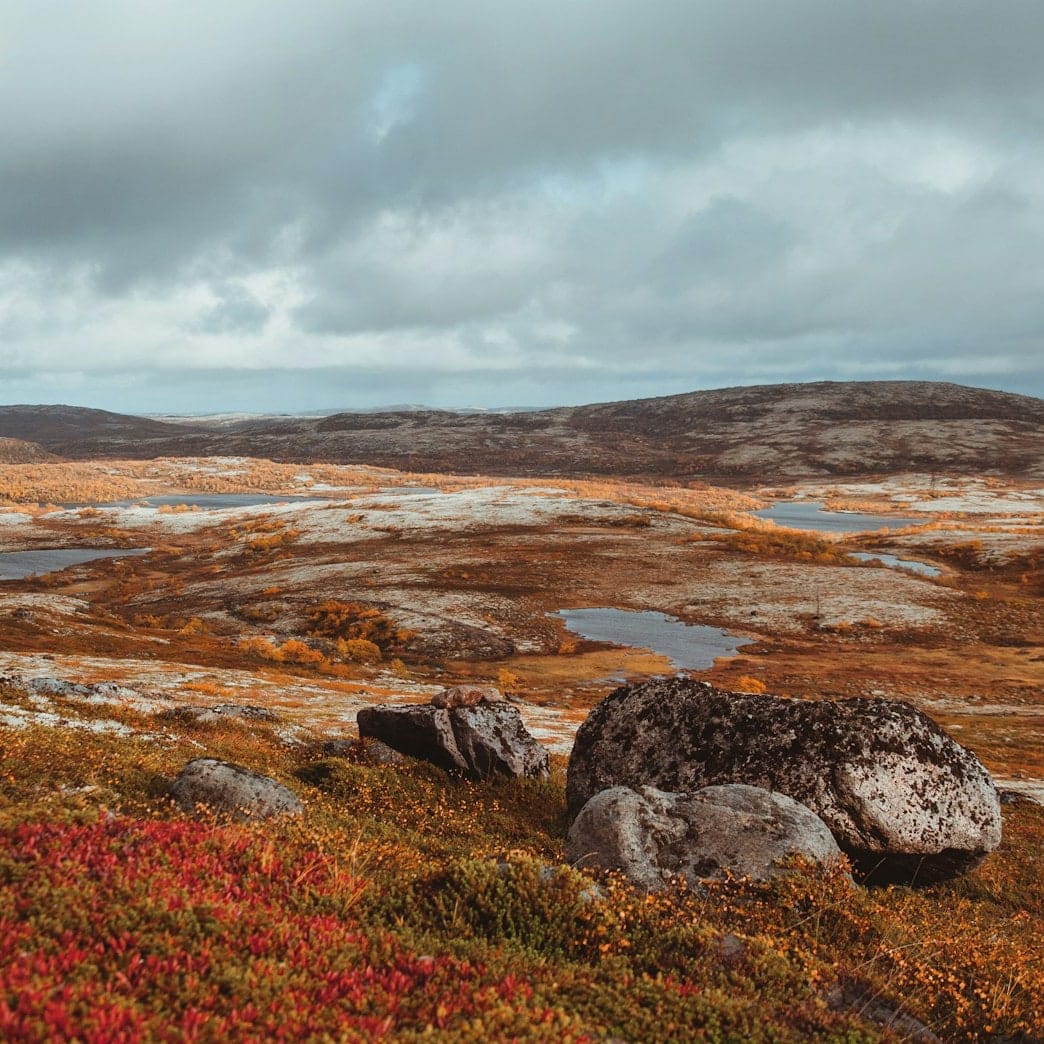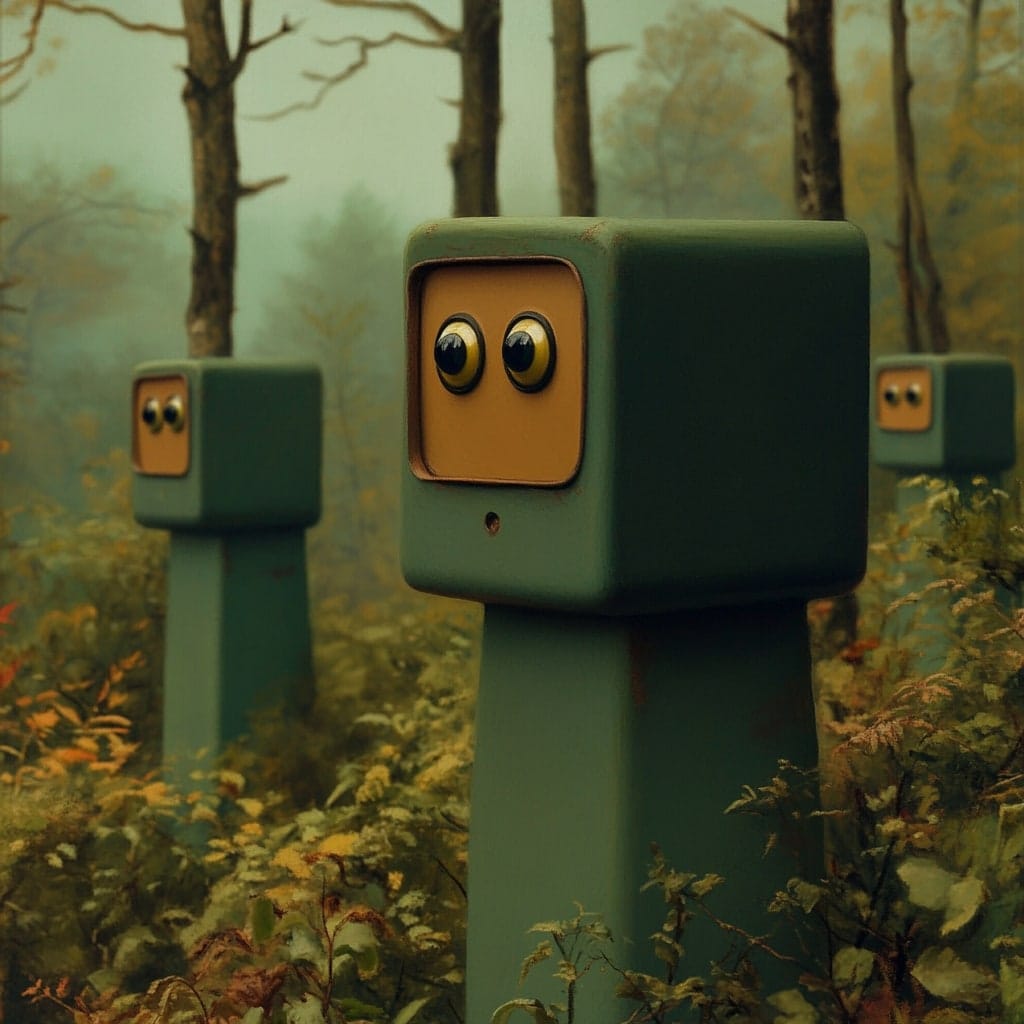On unstable ground ⊗ Intelligence evolved at least twice in vertebrate animals ⊗ Pixel agents, talking cars, and moving eyes
No.353 — On trees as infrastructure ⊗ Astrofuturism ⊗ China’s AI boom ⊗ The Bluetooth lady

On unstable ground
There are many huge moving pieces of the future(s) that we need to better understand/think/invent, this is one that we don’t hear as much about. The essay traces the global history of land ownership transformations, which the author, political scientist Christopher Carter, calls “the great land reshuffle.” He explains that nearly every society has experienced dramatic reallocations of land—from Indigenous communities to settlers, from landlords to tenants, and through various other mechanisms. These reshuffles have profoundly shaped societies, determining levels of equality, economic development, and racial hierarchies. Today, we face a new phase of land redistribution driven by population changes and climate crisis. As the global population approaches 10 billion before potentially declining in the 22nd century, and as climate change makes northern regions more habitable while rendering others uninhabitable, conventional property rights systems are proving inadequate. Carter argues that new approaches to land ownership—including layered rights that accommodate both individual and communal claims, conservation easements, and other flexible arrangements—will be essential for managing these transitions equitably and avoiding conflict.
I’d like to add two things. First, he writes as if thawing land and changing temperatures directly make new arable land, that’s not the case. Not all land is fit for agriculture and not just because some of it is frozen. Skipping over that weakens his argument. Second, Dark Matter Labs are doing quite a bit of work in that area. If the Aeon piece intrigues you, dig in to DML’s work.
Meanwhile, a changing climate will make vast areas of land more attractive and productive while rendering other areas uninhabitable. Amid these changes, the question is how to reshuffle land well. One thing is clear: centuries-old approaches to property rights and ownership are not up to that task. […]
Nigeria, with a fertility rate of 5.2 births per woman, could surpass China’s population before 2100. And the Democratic Republic of Congo, Ethiopia and Tanzania could become among the 10 most populous countries on Earth. […]
And alongside this thawing, governments, private interests and, where present, Indigenous communities, are poised to clash over sparsely populated territories like Greenland and Antarctica with weak, absent or transitional sovereignty. Indeed, under President Donald Trump, that has already begun. […]
Changing land relationships and migration patterns associated with climate change present a possibility to put land in service of society in ways that have rarely been attempted in human history. […]
Amid all these climatic and economic changes, future generations will make choices once again about whether to spread out on the land or to concentrate in shrinking cities. Land will once more undergo a radical reshuffle in either scenario.
Intelligence evolved at least twice in vertebrate animals
File this one under fascinating stuff, useful angles on better understanding “intelligence” (artificial ones being another version), and “we know so much yet so little.” The article discusses groundbreaking research suggesting that complex intelligence evolved independently in birds and mammals rather than stemming from a common ancestor. For decades, scientists debated this question, with some arguing that similar neural circuits in both groups indicated shared evolutionary origins, while others pointed to different developmental patterns suggesting independent evolution.
Recent studies using RNA sequencing techniques have provided evidence that birds and mammals evolved similar intelligence-supporting circuits through different developmental pathways. Though birds lack the layered neocortex found in mammals, their brain regions contain remarkably similar circuitry that enables comparable cognitive abilities—with birds demonstrating complex behaviours like planning, tool use, and counting despite having much smaller brains.
The circuits that composed the mammalian neocortex and the avian DVR developed at different times, in different orders and in different regions of the brain. […]
Innovations can happen throughout an animal’s biology, whether in new genes and their regulation, or in new neuron types, circuits and brain regions. But similar innovations can evolve multiple times independently — a phenomenon known as convergent evolution — and this is seen across life. […]
Octopuses and squids, independently of mammals, evolved camera-like eyes. Birds, bats and insects all took to the skies on their own. Ancient people in Egypt and South America independently built pyramids — the most structurally efficient shape that will stand the test of time.
AI UX: Pixel agents, talking cars, and moving eyes
In this post, Jay Springett examines emerging AI user experience through three examples of “little computer people” interfaces. First, he looks at Stevens, a pixel-based butler assistant that provides daily updates via Telegram, noting how top-down pixel art as an interface leverage users’ existing mental models from video games to make AI agent actions more comprehensible and observable. Second, the Little Guy hardware companion, which uses simple vector animations and googly eyes to create a sense of presence and personality, suggesting that expressive, character-based interfaces will become increasingly common (also see Aperture for little people eyes). Finally, Jay explores AI integration in Mercedes vehicles, where users sit “inside” the agent rather than alongside it, predicting this could lead to emotional attachments forming during commutes. He concludes by introducing “The Tamagotchi Imperative,” arguing that designers must plan for the end of AI relationships rather than presenting them as permanent, incorporating features like communicated lifespans, narrative endings, and memory archiving to create more humane digital relationships.
There’s something really uncanny about how effective this [use of moving eyes] is, AND its clear that this will be a UX paradigm int he near future. Things that work like a tamagotchi, combined with the magic of googly eyes. Suddenly, there’s a character. […]
There’s a meaning crisis going on, which means there is a gaping emotional void waiting to be filled by a good listener that’s found in the safety of a car. Some people, especially men, already love their cars. What happens when the car appears to care for them back? […]
Gradual Fade-out: Let responsiveness or features decline over time, gently, so the user reboots the model themselves without coercion.
Free panel idea, someone please make it so → Pick a few in this group, have them discuss little people in AI: Jay Springett (above), Matt Webb (multi-player interfaces), Matt Jones (Centaurs or Butlers?, BASAAP), oio (the real open AI), Special Projects (Aperture, linked above), Kate Darling (The New Breed). Not all of these ideas are new, but this seems like a great moment for such a panel.
Come to think of it, there’s definitely enough things happening at the fun/punk/transdisciplinary/art/llocal edges of AI that I can easily imagine a one day event, “AI without frontier models, startups, or bros.” Ping me if you’ve got the resources!

§ Grafting & Growth: On trees as infrastructure. Eleanor Konik explores the underappreciated potential of trees in worldbuilding. She argues that trees offer remarkable versatility for fictional worlds—they can serve as infrastructure (living bridges, homes), provide resources (food, medicine, textiles), purify water and air, and carry cultural significance. The piece also highlights real-world examples like wolf trees that connect ecosystems through fungal networks, self-fermenting palm sap, and bark cloth from Niger-Congo, alongside fictional examples from works by authors like Tolkien and Novik. ◼ Linked in the article; Remarkable trees throughout the world.
Futures, Fictions & Fabulations
- Astrofuturism. “Where modern magic meets feminism, capitalism and TikTok.”
- Six ‘snow leopards’ to watch for in 2025. “Under-the-radar trends and events that elude even the most seasoned observer. When their effect on world affairs eventually becomes apparent, they may seem to have come out of nowhere.”
- Foresight challenge: re-imagine a future. “How flexible, creative, immersive, emotionally provocative, and vivid is your future imagination? Take this fun ten-minute challenge to find out!” (Jane McGonigal)
Algorithms, Automations & Augmentations
- If your parents complain that they don’t hear from you, you can send an AI instead. Sadly, not The Onion. “At least, according to inTouch, which will make that call for you and spark “meaningful, mind-stimulating conversations with your parent.” On the flip side, focused on the elderly person, Amical “offers a comforting presence to seniors, helping them stay connected and engaged every day, while providing families with peace of mind knowing their loved ones are accompanied at all times.”
- China’s AI boom is driven by DeepSeek and chip restrictions. “DeepSeek has rapidly accelerated AI adoption throughout Chinese society. Chinese tech giants have released a wave of free, open-source AI models. Startups are under pressure to abandon foundational research as investors prioritize practical applications.”
- AI-generated images can exploit how your mind works − here’s why they fool you and how to spot them. “Misleading real or generated images can make false claims seem more believable and even cause people to misremember real events. AI-generated images have the power to shape opinions and spread misinformation in ways that are difficult to counter.”
Asides
- The Bluetooth lady. “Kristen DiMercurio went viral on TikTok when she revealed she was probably the voice of your Bluetooth speaker … and your headphones … and that gadget how-to video … and your insurer’s call center.”
- Astronomers detect a signature of life on a distant planet. “Known as K2-18b, that orbits a star 120 light-years from Earth. A repeated analysis of the exoplanet’s atmosphere suggests an abundance of a molecule that on Earth has only one known source: living organisms such as marine algae.”
- The first sighting of the Colossal Squid. “A full-grown colossal squid occasionally appears at the ocean’s surface, drawn up to a fishing boat while it’s “chewing on” a hooked fish, Dr. Bolstad said. Younger specimens have turned up in trawl nets. Yet until now, humans had not witnessed a colossal squid at home, swimming in the deep Antarctic sea.”
